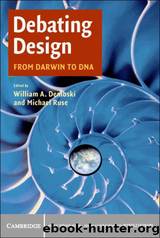Debating Design by Unknown

Author:Unknown
Language: eng
Format: epub
Publisher: Cambridge University Press
Published: 2004-09-22T23:00:00+00:00
4. The cosmological origin of timeâs arrow
The most plausible physical explanation for the improbable initial state of the universe comes from quantum cosmology, as expounded by Hawking, Hartle, and Gell-Mann.[17] In this program, quantum mechanics is applied to the universe as a whole. The resulting âwave function of the universeâ then describes its evolution. Quantum cosmology is beset with technical mathematical and interpretational problems, not the least of which is what to make of the infinite number of different branches of the wave function, which describes a superposition of possible universes. The favored resolution is the many-universes interpretation, according to which each branch of the wave function represents a really existing parallel reality, or alternative universe.
The many-universes theory neatly solves the problem of the origin of the arrow of time. The wave function as a whole can be completely time-symmetric, but individual branches of the wave function will represent universes with temporal directionality. This has been made explicit in the time-symmetric quantum cosmology of Hartle and Gell-Mann,[18] according to which the wave function of the universe is symmetric in time and describes a set of recontracting universes that start out with a Big Bang and end up with a big crunch. The wave function is the same at each temporal extremity (bang and crunch). However, this does not mean that time runs backward in the recontracting phase of each branch, Ã la Gold. To be sure, there are some branches of the wave function in which entropy falls in the recontracting phase, but these are exceedingly rare among the total ensemble of universes. The overwhelming majority of branches correspond to universes that either start out with low entropy and end up with high entropy, or vice versa. Because of the overall time symmetry, there will be equal proportions of universes with each direction of asymmetry. However, an observer in any one of these universes will by definition call the low-entropy end of the universe the Big Bang and the high-entropy end the big crunch. Without the temporal asymmetry implied, life and observers would be impossible, so there is an anthropic selection effect, with those branches of the universe that are thermodynamically bizarre (starting and ending in equilibrium) going unseen. Thus the ensemble of all possible universes shows no favored temporal directionality, although many individual branches do, and within those branches observers regard the âinitialâ cosmic state as exceedingly improbable. Although the HartleâGell-Mann model offers a convincing first step in explaining the origin of the arrow of time, it is not without its problems.[19]
To return to the description of our own universe (or our particular branch of the cosmological wave function), it is clear that the state of the universe in its early stages was one in which the matter and radiation were close to thermodynamic equilibrium, but the gravitational field was very far from equilibrium. The universe started, so to speak, with its gravitational clock wound up, but with the rest in an unwound state. As the universe expanded, there
Download
This site does not store any files on its server. We only index and link to content provided by other sites. Please contact the content providers to delete copyright contents if any and email us, we'll remove relevant links or contents immediately.
| Africa | Americas |
| Arctic & Antarctica | Asia |
| Australia & Oceania | Europe |
| Middle East | Russia |
| United States | World |
| Ancient Civilizations | Military |
| Historical Study & Educational Resources |
Machine Learning at Scale with H2O by Gregory Keys | David Whiting(4255)
Never by Ken Follett(3868)
Fairy Tale by Stephen King(3300)
The Man Who Died Twice by Richard Osman(3035)
Oathbringer (The Stormlight Archive, Book 3) by Brandon Sanderson(2977)
Will by Will Smith(2861)
Rationality by Steven Pinker(2321)
The Dark Hours by Michael Connelly(2278)
Can't Hurt Me: Master Your Mind and Defy the Odds - Clean Edition by David Goggins(2266)
Friends, Lovers, and the Big Terrible Thing by Matthew Perry(2174)
The Dawn of Everything: A New History of Humanity by David Graeber & David Wengrow(2151)
Principles for Dealing With the Changing World Order: Why Nations Succeed and Fail by Ray Dalio(2002)
HBR's 10 Must Reads 2022 by Harvard Business Review(1815)
A Short History of War by Jeremy Black(1811)
Go Tell the Bees That I Am Gone by Diana Gabaldon(1726)
A Game of Thrones (The Illustrated Edition) by George R. R. Martin(1653)
515945210 by Unknown(1639)
Kingdom of Ash by Maas Sarah J(1580)
443319537 by Unknown(1518)
